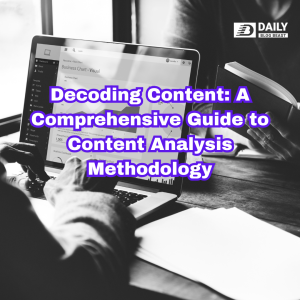Introduction:
The content analysis aims to identify recurrent patterns in qualitative data (here, text) by looking for recurrent words, themes, or concepts. Researchers can use content analysis to measure the frequency with which particular words, themes, or concepts appear and their meanings and connections to one another.
Researchers, for instance, can examine a news article’s text for signs of prejudice or partiality. Scholars might then conclude the writings’ messages, authors, readers, and even the historical context in which the texts were written.
Data could come from anything written or spoken (including but not limited to books, essays, dialogues, newspaper headlines, speeches, media, and historical documents), including interviews, open-ended questions, field study notes, chats, and so on. Multiple text types may be analyzed in a single study. Before performing content analysis, the text must be coded or split into manageable code categories for analysis (i.e., “codes”). The codes might be categorized into “code categories” after the text is coded to further summarise information.
Types of Content Analysis:
Conceptual analysis and relational analysis are the two main categories of content analysis. The procedures followed by these two types are very similar, yet the results are very different. This means that the outcomes, interpretations, and overall conclusions drawn from each variety may vary. In light of this, let’s analyze these two content types in greater detail.
Conceptual Content Analysis:
The conceptual analysis aims to locate and count instances of specific concepts within a body of text. Counting occurrences of a term in the text is one method of conducting conceptual analysis.
Explicit data is the usual emphasis of conceptual analysis, in which you zero in on one concept at a time to locate it within the text and count how often it appears.
There is also the option of using implicit data while performing a content analysis. This method is more time-consuming and laborious, necessitating a dictionary and/or translation rules based on context.
No of the type of qualitative research you conduct, the conceptual analysis incorporates quantitative analysis.
Relational Content Analysis:
Conceptual analysis is expanded upon in relational content analysis. While the approach begins with the same step—identifying concepts in content—it shifts its attention from counting how often a given concept appears to explore the connections among and between other concepts within the content.
Choosing the type of relationship analysis you’ll employ is the first step in conducting one.
Affect Extraction:
Using this method of relational content analysis, you will rank ideas according to how they make you feel. Typically, you’d rate these feelings using a ranking system where 10 is the best possible score and 0 is the lowest. As a result, you can feel the author’s or speaker’s intent as it was intended at the time the content was generated. The biggest problem with this method is that people’s feelings might change over time and between different groups.
Proximity Analysis:
Similar to conceptual analysis, this method involves identifying concepts before assessing how those concepts interact with one another in the text. In other words, you may use proximity analysis to examine the connections between ideas and construct a meaningful concept matrix. Facts, as opposed to context, emotion, or culture, are what proximity analysis is best for extracting.
Cognitive Mapping:
You can combine cognitive mapping with affect extraction or proximity analysis for good measure. You can use this method to produce a visual representation of the connections between ideas and the meaning of the content. As such, it is frequently employed in studies of how concepts evolve.
Reliability and Validity:
Having defined content analysis and explored its various applications, it is time to assess the validity of content analysis as a research strategy. We’ll also examine what factors can strengthen or weaken a content analysis’s credibility.
Criteria of Reliability:
Stability: The term “stability” describes how often coders apply the same classifications or codes to the same data.
Reproducibility: This criterion relates to the fact that coders tend to group items into the same categories.
Accuracy: The term “accuracy” is used to describe how well a content classification matches a given norm.
One thing to keep in mind is that human error is inevitable when manually coding or categorizing concepts for identification and analysis. However, you can lessen its impact.
Criteria of Validity:
The Closeness of Categories: Using implicit variables or synonyms, many classifiers can reach a consensus on what constitutes a given category. This way, the scope of the category can be extended to encompass additional information of use.
Conclusions:
Here, setting a boundary for acceptable inference is paramount. In other words, you need to consider whether the evidence supports the findings or if a different phenomenon may explain the results.
Analysis results that can be applied to a larger theoretical framework:
As we discussed previously, how well-defined and consistent your categories are is what ultimately determines generalizability. This, in turn, depends on how well the categories capture the thoughts or ideas you wish to quantify.


